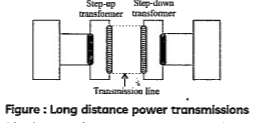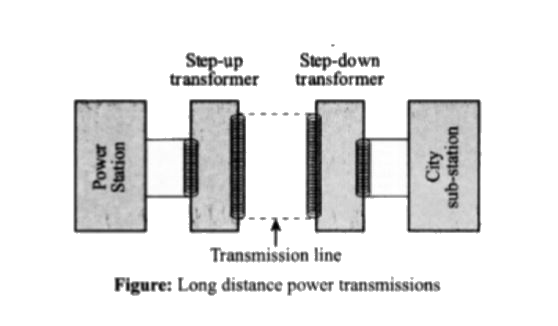(a) Draw a labelled diagram of a step-up transformer. Obtain the ratio of secondary to primary voltage in terms of number of turns and currents in the two coils.
(b) A power transmission line feeds input power at 2200 V to a step-down transformer with its primary windings having turns. Find the number of turns in the secondary to get the power output at .
and
are the no. of term of turn in primary and secondary coils respectively.
In step-up transformer
So,
In step-down transformer
So,
As energy is conserved the rate at which source transforms energy to the primary = rate at which primary transfers energy to secondary.

For a step-up transformer,
From faraday's law of Induction, induced emf/turn is same for both primary and secondary coil.
Also,
So,
.
Here,
turns.
Topper's Solved these Questions
- XII BOARDSBOOK - XII BOARDS PREVIOUS YEARCHAPTER - XII BOARDSEXERCISE - SET-II DELHI BOARD (SEC-B)
2 Videos
- XII BOARDSBOOK - XII BOARDS PREVIOUS YEARCHAPTER - XII BOARDSEXERCISE - SET-II DELHI BOARD (SEC-C)
5 Videos
- XII BOARDSBOOK - XII BOARDS PREVIOUS YEARCHAPTER - XII BOARDSEXERCISE - SET-I (SECTION-D)
1 Videos
- SAMPLE PAPER 2019BOOK - XII BOARDS PREVIOUS YEARCHAPTER - SAMPLE PAPER 2019EXERCISE - SECTION D
6 Videos
Similar Questions
A power transmission line feeds input potential at 2200 V to a step down transformer with its primary winding having 3000 turns. Find the number of turns in secondary to get the power output at 220 V.
View Solution(a) Draw a labelled diagram of a step-up transformer. Obtain the ratio of secondary to primary voltage in terms of number of turns and currents in the two coils.
(b) A power transmission line feeds input power at 2200 V to a step-down transformer with its primary windings having 3000 turns. Find the number of turns in the secondary to get the power output at 220V.
View Solution
Knowledge Check
A power transmission line feeds input power at 2400 V to a step down transformer with its primary windings having 4000 turns. What should be the number of turns in the secondary windings in order to get output power at 240 V?
A400B420C424D436
Figure : Long distance power transmissions The large-scale transmission and distribution of electrical energy over long distances is done with the use of transformers. The voltage output of the generator is stepped-up. It is then transmitted over long distances to an area sub station near the consumers. There the voltage is stepped down. It is further stepped down at distributing sub-stations and utility poles before a power supply of 240 V reaches our homes.
A power transmission line feeds input power. at 2300 V to a step down transformer with its primary windings having 4000 turns. The number of turns in the secondary in order to get output power at 230 V are :A4B40C400D4000In a step - down transformer the input voltage is 22kV and the output voltage is 550V The ratio of the number of turns in the secondary to that in the primary is .
A1:20B20:1C1:40D40:1
A power tansmission line feeds input input power at 2200 V to a step down transformer with its primary windings having 3000 turns. Find the number of turns in secondary to get the power output at 220 V.
View SolutionA power transmission line feeds input power at 2300 V to a step-down transformer with its primary windings having 4000 turns. What should be the number of turns in the secondary in order to get output power at 230 V ?
View SolutionA power transmission line feeds input power at 2300 V to a step down trnasformer with it primary windings having 4000 turns. What should be the number of turns in the seconday windings in order to get output power at 230 V?
View SolutionA power transmission line feeds input power at 2400 V to a step down transformer with its primary windings having 4000 turns. What should be the number of turns in the secondary windings in order to get output power at 240 V?
View SolutionCase study :
Read the following paragraph and answers the questions :

The large-scale transmission and distribution of electrical energy over long distances is done with the use of transformers. The voltage output of the generator is stepped-up. It is then transmitted over long distances to an area sub-station near the consumers. There the voltage is stepped down. It is further stepped down at distributing sub-stations and utility poles before a power supply of 240 V reaches our homes.
A power transmission line feeds input power at 2300 V to a step down transformer with its primary windings having 4000 turns. The number of turns in the secondary in order to get output power at 230 V are
View Solution
